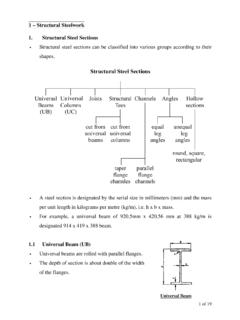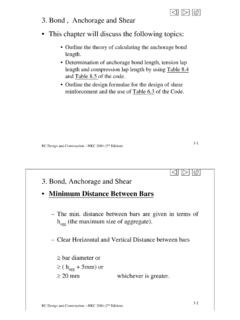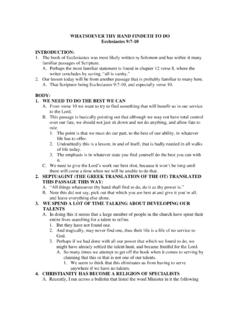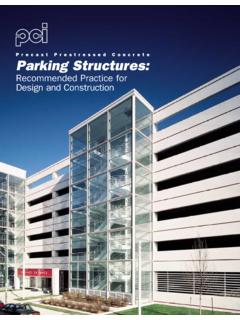Transcription of 3 Tunnelling 1. Introduction 2. Type of Tunnels …
1 1/24 3 tunnelling 1 . Introduction Tunnels can be defined as underground passages constructed for the purpose of transportation connection between two points. 2. Type of Tunnels There are many types of Tunnels and can be classified in many ways: Classified by Example of Tunnels Purpose Railway Tunnels , metro system, highway Tunnels , pedestrian Tunnels , water Tunnels , sewage Tunnels , services Tunnels , storage Tunnels . Geological location / condition Rock Tunnels , earth Tunnels , and submerged Tunnels . Cross-sectional shapes Rectangular shape, circular shape, elliptical shape, egg shape, horse shoe shape, and segmental shape. 3. Shapes of Tunnel Lining The shapes of tunnel linings are usually determined by their purpose, ground conditions, construction method and/or lining materials.
2 2/24 Rectangular shape Rectangular shaped Tunnels are usually adopted by the cut and cover method. It is particular suitable for pedestrian and highway Tunnels . On the other hand, multi-lane submerged highway Tunnels are often in rectangular shape. Elliptical shape / Egg shape Elliptical shape Tunnels have the advantages for the transportation of sewer. The smaller cross section at the bottom maintains the flow at the required self-cleaning velocity. However, due to the difficulty in construction, circular shape ones are more common. Circular shape A circular shape tunnel has the greatest cross-sectional area to perimeter ratio. They are often associated with TBM or the shield Tunnelling methods.
3 Horseshoe / segmental shape They are commonly used for rock Tunnelling . It has the advantages of utilising the compressive strength of concrete in resisting the loading by means of arch action and the base is wide enough for traffic. Different Shapes of Tunnels 3/24 4. Tunnel lining materials Permanent linings are required in most Tunnels , always in soft ground and frequently in rock. They are required for two purposes: structurally to retain the earth and water pressure, and operationally to provide an internal surface appropriate to the function of the tunnel. The principal materials for permanent lining of bored Tunnels are: Brickwork, blockwork and masonry Brickwork, blockwork and masonry had been used for tunnel lining but now they are obsolete.
4 Insitu concrete Insitu concrete lining is frequently in rock Tunnelling where the roof is able to stay unsupported temporary. Specially designed travelling formwork is used for casting the concrete. Travelling Form for Tunnel Lining Construction 4/24 Preformed segments Preformed segments may be made of cast iron, steel or normal reinforced concrete. This type of lining usually comes with TBM or shield Tunnelling methods. The segments are jointed together by bolting and the joints are sealed with neoprene gasket. Sometimes the joints are also caulked with rubberised bituminous strips. Voids behind the preformed segments are filled by bentonite cement grout.
5 Tunnel Lining Reinforcement Concreting for Tunnel Lining 5/24 Sprayed Concrete for Tunnel Lining Preformed Segments for Tunnel Lining Sprayed Concrete Sprayed concrete linings usually compose of rock bolts, wire mesh, steel ribs and a thin layer or sprayed concrete. This kind of lining is rather flexible than other types of linings. The use of sprayed concrete lining is usually associated with the New Austrian Tunnelling Method (NATM). NATM technology will be discussed later. 6/24 Open cut Tunnelling 5. Tunnelling Methods on Land Open Cut Open cut method often refers to excavation with battered sides such that no lateral support is required.
6 In its simplest form, a trench is excavated, the tunnel structure is built, the trench is backfilled and the surface is restored. Precast tunnel units can also be employed to speed up to construction process. The major problem of this method is the procession of land so that it is not too suitable in urban areas. Moreover, it is only suitable for shallow Tunnels only because with increased depth, direct costs of trench excavation and backfilling increase rapidly. Cut and Cover Method The construction process of cut and cover method is very similar to that of open cut method except that the excavation sides are vertical and temporary supported are provided. The main problems associated with cut and cover method are the stability of the soft ground, impact on the existing underground services & utilities and traffic disruption in urban areas.
7 7/24 Pre-deck method of tunneling (R. Holmes) Temporary steel decks may be used to maintain the traffic while the construction works proceeds underneath. This method is also only suitable for high level Tunnels . Pre-Deck Method Same as the open-cut method, the pre-deck method is suitable for high level Tunnels . The tunnel walls are constructed by the diaphragm walling method first and then the upper surface of the ground is removed. The upper deck of the tunnel is cast supported on the diaphragms. It is then backfilled and the road surface is reinstated. Now the tunnel excavation can started from both ends of the tunnel without the fear of collapse and with minimum disturbance to traffic and services.
8 Temporary Steel Deck for Traffic Shoring for Tunnel Trench 8/24 Pipe Jacking Pipe jacking Method This method can be used for the installation of pipes from 150 mm to 4 m diameter, or box section up to 7 x 4 m, but it is mainly employed on the larger diameter pipes of over 1 m. This method is very suitable for installing services under roads and railway embankments without creating disturbance to traffic. The method consists of forming pits at both ends of the proposed tunnel. A thrust wall is constructed to provide jacking reaction and pipe segments are jacked into the soil. For small diameter pipes, bullet-shaped solid metal heads are fixed to the leading end of the pipe, which is jacked into the ground displacing the earth.
9 For Tunnels of diameter 1 m or above, the leading pipe is fitted with a steel shield to aid the driving process. The shield provides protection under which the 9/24 Pipe Jacking Method Intermediate Jacks Micro TBM workers excavate the tunnel face. New pipe segments are added from the starting pit and jacked forward one by one until the pipe length reaches the opposite pit. Another modern method of boring the tunnel shaft is by using micro TBM. The excavated spoil is liquefied by mixing with bentonite slurry and removed by pump and pipeline. For large diameter pipes or for long pipes, the friction will be very great and it creates problems in providing suitable jacking reaction. A method to counteract the friction is the Introduction of intermediate jacks.
10 The intermediate jacks are fixed on steel sleeves which are installed at suitable intervals along the pipe length. The line is then jacked forward in a caterpillar fashion. In addition, bentonite slurry can be introduced from the rear of the driving shield as lubricant to reduce the friction. Hydraulic Jacks at Starting Pit 10/24 Shield Tunnelling Method The technique of shield Tunnelling method is very similar to pipe jacking method, except that prefabricated segments are used for lining and are installed right behind the shield. Use of Compressed Air in Tunneling When Tunnelling in water bearing ground, ground water infiltration will create problems. The ground water can be excluded by the Introduction of compressed air.










